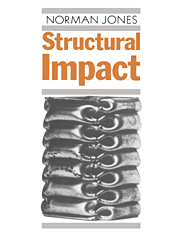Book contents
- Frontmatter
- Contents
- Preface
- 1 Static plastic behaviour of beams
- 2 Static plastic behaviour of plates and shells
- 3 Dynamic plastic behaviour of beams
- 4 Dynamic plastic behaviour of plates
- 5 Dynamic plastic behaviour of shells
- 6 Influence of transverse shear and rotatory inertia
- 7 Influence of finite displacements
- 8 Strain rate sensitive behaviour of materials
- 9 Dynamic progressive buckling
- 10 Dynamic plastic buckling
- 11 Scaling laws
- Appendices
- References
- Answers to selected problems
- Subject index
- Author index
1 - Static plastic behaviour of beams
Published online by Cambridge University Press: 09 January 2010
- Frontmatter
- Contents
- Preface
- 1 Static plastic behaviour of beams
- 2 Static plastic behaviour of plates and shells
- 3 Dynamic plastic behaviour of beams
- 4 Dynamic plastic behaviour of plates
- 5 Dynamic plastic behaviour of shells
- 6 Influence of transverse shear and rotatory inertia
- 7 Influence of finite displacements
- 8 Strain rate sensitive behaviour of materials
- 9 Dynamic progressive buckling
- 10 Dynamic plastic buckling
- 11 Scaling laws
- Appendices
- References
- Answers to selected problems
- Subject index
- Author index
Summary
Introduction
Many ductile materials which are used in engineering practice have a considerable reserve capacity beyond the initial yield condition. The uniaxial yield strain of mild steel, for example, is 0.001 approximately, whereas this material ruptures, in a standard static uniaxial tensile test, at an engineering strain of 0.3, approximately. This reserve strength may be utilised in a structural design to provide a more realistic estimate of the safety factor against failure for various extreme loads. Thus, the static plastic behaviour of structures has been studied extensively and is introduced in many textbooks. An interested reader is referred to these textbooks for a deeper presentation of the subject than is possible in this book, which is concerned primarily with the influence of dynamic loadings. However, the methods of dynamic structural plasticity presented in this book owe a substantial debt to the theoretical foundation of static structural plasticity, which is, therefore, reviewed briefly in this chapter and the following one.
A considerable body of literature is available on the static behaviour of structures made from ductile materials which may be idealised as perfectly plastic. This simplification allows the principal characteristics and overall features of the structural response to be obtained fairly simply for many important practical cases. Moreover, the static collapse loads predicted by these simplified methods often provide good estimates of the corresponding experimental values. Indeed, the design codes in several industries now permit the use of plasticity theory for the design of various structures and components.
- Type
- Chapter
- Information
- Structural Impact , pp. 1 - 21Publisher: Cambridge University PressPrint publication year: 1990



